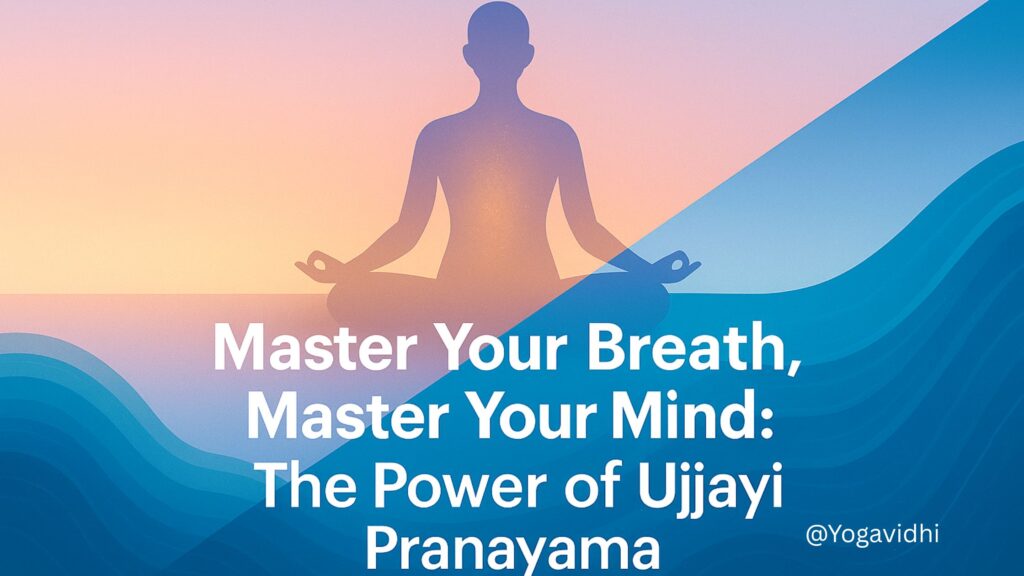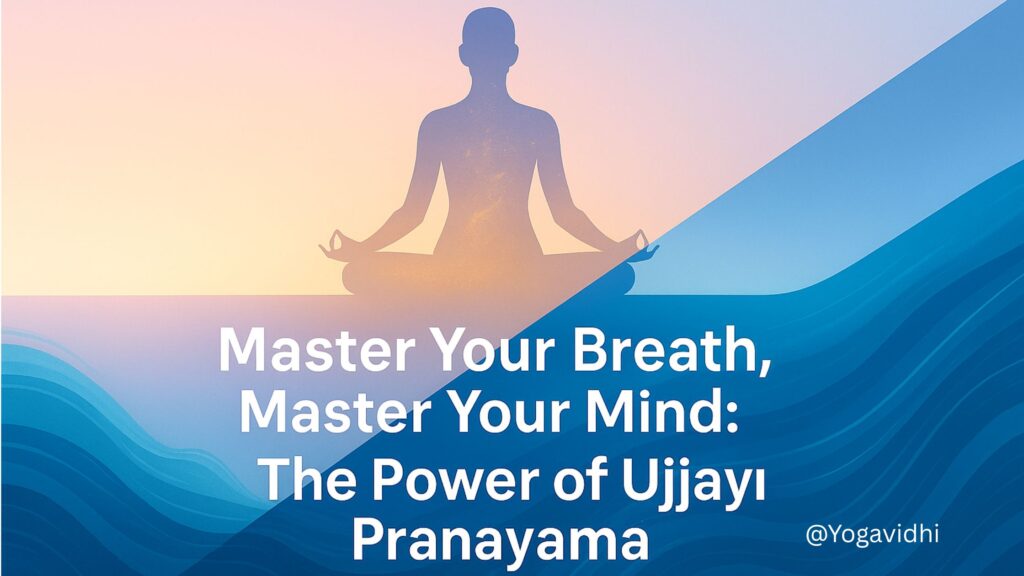In today’s fast-paced lifestyle, stress, anxiety, and lack of focus have become common companions. Many people turn to yoga for holistic solutions that not only strengthen the body but also bring peace to the mind. Among the various breathing techniques in yoga, Ujjayi Pranayama stands out as a powerful yet simple practice. Known as the “Victorious Breath” or “Ocean Breath,” it creates a soothing sound that resembles gentle ocean waves, calming the mind and energizing the body at the same time.
Practiced widely in Ashtanga Yoga, Vinyasa Yoga, and meditation, Ujjayi pranayama is not just a breathing exercise—it’s a bridge between physical practice and spiritual awakening. Let’s explore how this ancient yogic technique can help you cultivate clarity, mindfulness, and energy in your everyday life.
Ujjayi Pranayama, also known as the Victorious Breath, is a yogic breathing practice that requires gently constricting the throat to generate a soft, ocean-like sound during both inhalation and exhalation through the nose. This steady and mindful breathing technique helps regulate the nervous system, create inner warmth, quiet the mind, and enhance focus and stability during yoga poses. To perform it, breathe slowly in and out through the nose while slightly narrowing the glottis, allowing a calming, friction-like sound to emerge at the back of the throat.
Table of Contents
What is Ujjayi Pranayama?
The word Ujjayi comes from Sanskrit, where ud means “upward” and jaya means “victory” or “success.” Together, Ujjayi pranayama translates to “the victorious breath.” The name itself suggests empowerment—mastering your breath helps you master your mind.
Unlike normal breathing, Ujjayi pranayama involves a slight constriction of the throat (glottis), creating a soft hissing or ocean-like sound. This sound is not just for effect—it helps regulate the breath, anchor the mind, and deepen your focus.
Practitioners often use Ujjayi pranayama during yoga asanas because it creates rhythm, builds internal heat, and enhances concentration. However, it is equally beneficial when practiced on its own for relaxation and meditation.
Steps to Practice Ujjayi Pranayama
If you’re new to pranayama, Ujjayi is a great starting point because it’s simple, safe, and effective. Follow these step-by-step instructions:
- Find a Comfortable Position
Sit cross-legged on the floor (Padmasana, Sukhasana, or Vajrasana), or if sitting is uncomfortable, you may lie down in Shavasana. Keep your spine straight and shoulders relaxed. - Inhale Slowly Through the Nose
Begin by inhaling deeply through the nose. Slightly contract the muscles in your throat so that you hear a soft hissing or whispering sound. The sound should be gentle, like the ocean—not forced. - Exhale With Awareness
Exhale slowly through the nose, maintaining the same throat contraction. The sound continues as you breathe out, creating a rhythmic flow. - Focus on the Sound and Sensation
Keep your awareness on the breath and the sound it produces. This auditory anchor prevents the mind from wandering. - Establish a Steady Rhythm
Aim for slow, even breaths. Beginners may start with 5–10 minutes, gradually increasing to 20 minutes as they grow comfortable.
Techniques and Variations of Ujjayi Pranayama
1. Basic Ujjayi Breath (for Beginners)
This involves simply creating the oceanic sound while breathing naturally. Perfect for calming the mind and preparing for meditation.
2. Ujjayi with Retention (Kumbhaka)
Advanced practitioners may hold the breath after inhalation or exhalation. This enhances lung capacity and builds inner energy.
3. Ujjayi in Asana Practice
In dynamic practices like Vinyasa Flow or Ashtanga Yoga, Ujjayi breath is synchronized with movement. It helps maintain stamina, creates meditative flow, and regulates body temperature.
Read More: Kapalabhati Pranayama – The Skull-Shining Breath for Detox, Energy & Clarity
Read More: Bhramari Pranayama – The Humming Bee Breath for Stress Relief and Inner Calm
Benefits of Ujjayi Pranayama
Practicing Ujjayi pranayama offers a wide range of physical, mental, and spiritual benefits.
Physical Benefits
- Improves lung capacity and oxygen intake
- Strengthens the diaphragm and throat muscles
- Stimulates the parasympathetic nervous system for relaxation
- Helps regulate body temperature during intense yoga practice
- Improves circulation and supports heart health
Mental Benefits
- Reduces stress and anxiety by calming the nervous system
- Improves focus, concentration, and memory
- Induces a meditative state of mind
- Helps manage insomnia by promoting relaxation
Spiritual Benefits
- Balances prana (life force energy) in the body
- Enhances awareness and mindfulness
- Creates inner heat, which purifies the mind and body
- Deepens the connection between breath and consciousness
| Aspect | Details |
| Meaning | Victorious Breath / Ocean Breath |
| Steps | Sit comfortably → Inhale with throat contraction → Exhale slowly → Focus on sound |
| Duration | 5–20 minutes daily |
| Benefits | Reduces stress, improves focus, increases lung capacity, calms mind |
| Precautions | Avoid if severe respiratory/heart issues; don’t strain throat |
| Best Practice Time | Early morning or during yoga practice |
Precautions and Contraindications
While Ujjayi pranayama is safe for most people, certain precautions should be kept in mind:
- Avoid if you suffer from severe respiratory issues, throat infections, or extreme fatigue.
- People with uncontrolled hypertension or heart disease should practice under expert guidance.
- Always practice on an empty stomach.
- Do not strain your throat—if you feel discomfort, release and breathe normally.
Tips for Beginners
If you are new to Ujjayi pranayama, here are some helpful tips to make your practice effective:
- Start slow: Practice for 5 minutes and gradually increase.
- Focus on quality, not quantity: It’s better to take fewer mindful breaths than to force longer sessions.
- Use during yoga: Try Ujjayi breathing during poses like Downward Dog or Warrior Pose for better stability.
- Stay relaxed: The sound should be soothing, not harsh.
Ujjayi Pranayama vs Other Pranayamas
- Ujjayi vs Kapalabhati: Ujjayi is slow, calming, and meditative, while Kapalabhati is fast, energizing, and cleansing.
- Ujjayi vs Bhramari: Bhramari uses a humming sound during exhalation, whereas Ujjayi uses a whisper-like ocean sound throughout the breath.
- When to choose Ujjayi: For relaxation, focus, and deep yoga practice, Ujjayi pranayama is ideal.
Scientific Perspective on Ujjayi Pranayama
Modern research shows that Ujjayi pranayama positively influences the autonomic nervous system by activating the parasympathetic response. This lowers heart rate, reduces blood pressure, and creates a sense of calm.
Studies also highlight that deep breathing with slight throat contraction improves oxygenation and supports better lung health, making it beneficial for people with mild respiratory challenges. Furthermore, the rhythmic sound enhances mindfulness, similar to mantra meditation.

Conclusion
Ujjayi pranayama is more than just a breathing technique—it is a tool for empowerment, mindfulness, and healing. Whether you’re a beginner looking to reduce stress or an advanced yogi aiming to deepen your practice, this Victorious Breath can transform your inner and outer world.
By practicing regularly, you’ll not only improve your lung capacity and mental focus but also experience greater peace, clarity, and inner strength. If you want a simple yet powerful way to calm your mind and elevate your yoga practice, Ujjayi pranayama is the key.
FAQs on Ujjayi Pranayama:
Q. What is Ujjayi pranayama good for?
Ans: It reduces stress, improves focus, enhances lung capacity, and balances energy during yoga practice.
Q. Can beginners practice Ujjayi pranayama?
Ans: Yes, it is safe for beginners and can be practiced for 5–10 minutes daily.
Q. How long should you practice Ujjayi pranayama?
Ans: Start with 5–10 minutes and gradually increase to 20 minutes for maximum benefits.
Q. Why is Ujjayi pranayama called the “Victorious Breath”?
Ans: Because it helps you gain victory over the restless mind, stress, and distractions.
Q. Can Ujjayi pranayama be done lying down?
Ans: Yes, it can be practiced in Shavasana for relaxation and meditation.
Q. What is the meaning of Ujjayi Pranayama?
Ans: “Ujjayi [pranayama]” (Sanskrit: उज्जायी) translates to “victorious” or “conquering breath” in Sanskrit. As explained by B. K. S. Iyengar, the prefix ut signifies superiority, while jaya refers to victory or conquest.
Q. What is the science behind Ujjayi breathing?
Ans: Ujjayi breathing caused a greater increase in heart rate compared to slow breathing alone. Slow breathing lowered both systolic and diastolic blood pressure, especially when the duration of inhalation and exhalation was equal. However, Ujjayi minimized the reduction in blood pressure that typically occurs with simple slow breathing.
Q. How many times Ujjayi Pranayama?
Ans: You can begin practicing Ujjayi Pranayama for 5–15 minutes daily and gradually extend it to 10–20 minutes as you progress. Another option is to start with 7–11 rounds twice a day, adjusting the count according to your breath control and comfort. The exact duration varies with your experience, but the most important part is to maintain a slow, gentle, and relaxed breath to fully experience its benefits.
Declaration Note:
We use third-party videos and images on https://yogavidhi.com/ for educational and illustrative purposes. All rights belong to their respective owners. No copyright infringement is intended.



